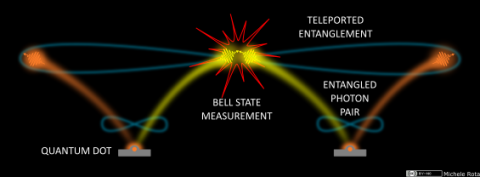Teleportation of quantum entanglement with photons from artificial atoms

The Nanophotonics group of the Physics Department lead by Prof. Rinaldo Trotta has demonstrated, for the first time, that solid-state based nanostructures can be used to perform one of the fundamental protocols in the operation of an optical quantum network, i.e. entanglement swapping.
This work is the result of an ongoing collaboration between the Nanophotonics group, the Institute of Semiconductor and Solid-State Physics of the Johannes Kepler University in Linz (Austria), and the Department of Applied Physics, Royal Institute of Technology, Stockholm (Sweden) and was recently published in Physical Review Letters (https://journals.aps.org/prl/abstract/10.1103/PhysRevLett.123.160501).
The focus of this work is on the possibility to imprint quantum entanglement to independent photons that were not correlated before via the chain event process known as entanglement teleportation or entanglement swapping.
Supported by the steady progress of semiconductor quantum optics, the researchers successfully implemented the protocol using semiconductor quantum dots, i.e., nanostructures that are often referred to as artificial atoms.
This is the first time that photons generated by a quantum emitter are used in an entanglement teleportation protocol involving four photons. While the performance of the photon source has still to be improved for practical quantum networks, the researchers argue that a strategy with realistic top-down fabrication steps can be put in place to achieve push-button operation in the foreseeable future.
Reference
Phys. Rev. Lett. 123, 160501 (2019)
Authors
Rinaldo Trotta
